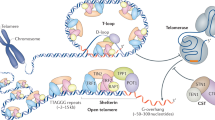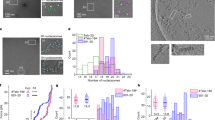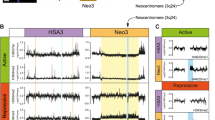Abstract
Telomeres were defined by their ability to cap chromosome ends1,2. Proteins with high affinity for the structure at chromosome ends, binding the G-rich, 3′ single-stranded overhang at telomeres include Pot1 in humans and fission yeast, TEBP in Oxytricha nova and Cdc13 in budding yeast3,4,5. Cdc13 is considered essential for telomere capping because budding yeast that lack Cdc13 rapidly accumulate excessive single-stranded DNA (ssDNA) at telomeres, arrest cell division and die6,7,8. Cdc13 has a separate, critical role in telomerase recruitment to telomeres9,10. Here, we show that neither Cdc13 nor its partner Stn1 are necessary for telomere capping if nuclease activities that are active at uncapped telomeres are attenuated. Recombination-dependent and -independent mechanisms permit maintenance of chromosomes without Cdc13. Our results indicate that the structure of the eukaryotic telomere cap is remarkably flexible and that changes in the DNA damage response allow alternative strategies for telomere capping to evolve.
This is a preview of subscription content, access via your institution
Access options
Subscribe to this journal
Receive 12 print issues and online access
$259.00 per year
only $21.58 per issue
Buy this article
- Purchase on SpringerLink
- Instant access to full article PDF
Prices may be subject to local taxes which are calculated during checkout





Similar content being viewed by others
References
Muller, H. J. The remaking of chromosomes. The Collecting Net 13, 181–198 (1938).
McClintock, B. The stability of broken ends of chromsomes in Zea mays. Genetics 26, 234–282 (1941).
Lei, M., Podell, E. R. & Cech, T. R. Structure of human POT1 bound to telomeric single-stranded DNA provides a model for chromosome end-protection. Nature Struct. Mol. Biol. 11, 1223–1229 (2004).
Mitton-Fry, R. M., Anderson, E. M., Theobald, D. L., Glustrom, L. W. & Wuttke, D. S. Structural basis for telomeric single-stranded DNA recognition by yeast Cdc13. J. Mol. Biol. 338, 241–255 (2004).
Theobald, D. L., Cervantes, R. B., Lundblad, V. & Wuttke, D. S. Homology among telomeric end-protection proteins. Structure 11, 1049–1050 (2003).
Garvik, B., Carson, M. & Hartwell, L. Single-stranded DNA arising at telomeres in cdc13 mutants may constitute a specific signal for the RAD9 checkpoint. Mol. Cell. Biol. 15, 6128–6138 (1995).
Lydall, D. & Weinert, T. Yeast checkpoint genes in DNA damage processing: implications for repair and arrest. Science 270, 1488–1491 (1995).
Zubko, M. K., Guillard, S. & Lydall, D. Exo1 and Rad24 differentially regulate generation of ssDNA at telomeres of Saccharomyces cerevisiae cdc13-1 mutants. Genetics 168, 103–115 (2004).
Nugent, C. I., Hughes, T. R., Lue, N. F. & Lundblad, V. Cdc13p: a single-strand telomeric DNA-binding protein with a dual role in yeast telomere maintenance. Science 274, 249–252 (1996).
Evans, S. K. & Lundblad, V. Est1 and Cdc13 as comediators of telomerase access. Science 286, 117–120 (1999).
Gardner, R. G., Nelson, Z. W. & Gottschling, D. E. Degradation-mediated protein quality control in the nucleus. Cell 120, 803–815 (2005).
Maringele, L. & Lydall, D. EXO1-dependent single-stranded DNA at telomeres activates subsets of DNA damage and spindle checkpoint pathways in budding yeast yku70Δ mutants. Genes Dev. 16, 1919–1933 (2002).
Downey, M. et al. A genome-wide screen identifies the evolutionarily conserved KEOPS complex as a telomere regulator. Cell 124, 1155–1168 (2006).
Grandin, N., Damon, C. & Charbonneau, M. Cdc13 prevents telomere uncapping and Rad50-dependent homologous recombination. EMBO J. 20, 6127–6139 (2001).
Teng, S. C. & Zakian, V. A. Telomere–telomere recombination is an efficient bypass pathway for telomere maintenance in Saccharomyces cerevisiae. Mol. Cell. Biol. 19, 8083–8093 (1999).
Lundblad, V. & Blackburn, E. H. An alternative pathway for yeast telomere maintenance rescues est1− senescence. Cell 73, 347–360 (1993).
Maringele, L. & Lydall, D. EXO1 plays a role in generating type I and type II survivors in budding yeast. Genetics 166, 1641–1649 (2004).
Maringele, L. & Lydall, D. Telomerase- and recombination-independent immortalization of budding yeast. Genes Dev. 18, 2663–2675 (2004).
Baumann, P. & Cech, T. R. Pot1, the putative telomere end-binding protein in fission yeast and humans. Science 292, 1171–1175 (2001).
Liti, G. & Louis, E. J. NEJ1 prevents NHEJ-dependent telomere fusions in yeast without telomerase. Mol. Cell 11, 1373–1378 (2003).
Pennock, E., Buckley, K. & Lundblad, V. Cdc13 delivers separate complexes to the telomere for end protection and replication. Cell 104, 387–396 (2001).
Bertuch, A. A. & Lundblad, V. EXO1 contributes to telomere maintenance in both telomerase-proficient and telomerase-deficient Saccharomyces cerevisiae. Genetics 166, 1651–1659 (2004).
Lin, J., Smith, D. L. & Blackburn, E. H. Mutant telomere sequences lead to impaired chromosome separation and a unique checkpoint response. Mol. Biol. Cell 15, 1623–1634 (2004).
d'Adda di Fagagna, F., Teo, S. H. & Jackson, S. P. Functional links between telomeres and proteins of the DNA-damage response. Genes Dev. 18, 1781–1799 (2004).
Ferreira, M. G., Miller, K. M. & Cooper, J. P. Indecent exposure: when telomeres become uncapped. Mol. Cell 13, 7–18 (2004).
Abad, J. P. et al. Genomic analysis of Drosophila melanogaster telomeres: full-length copies of HeT-A and TART elements at telomeres. Mol. Biol. Evol. 21, 1613–1619 (2004).
Maringele, L. & Lydall, D. The PAL-mechanism of chromosome maintenance: causes and consequences. Cell Cycle 4, 747–751 (2005).
Reddel, R. R. Alternative lengthening of telomeres, telomerase, and cancer. Cancer Lett. 194, 155–162 (2003).
Longtine, M. S. et al. Additional modules for versatile and economical PCR-based gene deletion and modification in Saccharomyces cerevisiae. Yeast 14, 953–961 (1998).
Maringele, L. & Lydall, D. in Yeast Protocols: Methods in Cell and Molecular Biology, 2nd edn (ed. Xiao, W.) 65–73 (Humana Press, Totowa, 2006).
Acknowledgements
We thank all members of our lab for input, particularly S. Foster for providing a CDC15 probe, and T. Kirkwood, L. Maringele, C. Nugent, G. Sareztki, R. Wellinger and T. von Zglinicki for comments on the manuscript. We are grateful to C. Nugent and R. Wellinger for communicating data before publication. This work was supported by the Wellcome Trust (Grant numbers 054371and 075294).
Author information
Authors and Affiliations
Contributions
M.Z. performed all experiments and made the initial observation that cdc13-1 mutants could grow at 36 °C. M.Z. and D.L. designed subsequent experiments. D.L. wrote the bulk of the paper.
Corresponding author
Ethics declarations
Competing interests
The authors declare no competing financial interests.
Supplementary information
Supplementary Information
Supplementary Figures S1, S2, S3, S4, Supplementary Tables S1, S2, S3 and Supplementary Data (PDF 877 kb)
Rights and permissions
About this article
Cite this article
Zubko, M., Lydall, D. Linear chromosome maintenance in the absence of essential telomere-capping proteins. Nat Cell Biol 8, 734–740 (2006). https://doi.org/10.1038/ncb1428
Received:
Accepted:
Published:
Issue date:
DOI: https://doi.org/10.1038/ncb1428
This article is cited by
-
Yeast Stn1 promotes MCM to circumvent Rad53 control of the S phase checkpoint
Current Genetics (2022)
-
Co-operative inhibitory effects of hydrogen peroxide and iodine against bacterial and yeast species
BMC Research Notes (2013)
-
Rudimentary G-quadruplex–based telomere capping in Saccharomyces cerevisiae
Nature Structural & Molecular Biology (2011)
-
Telomere capping in Drosophila: dealing with chromosome ends that most resemble DNA breaks
Chromosoma (2008)
-
A common means to an end
Nature Structural & Molecular Biology (2007)



